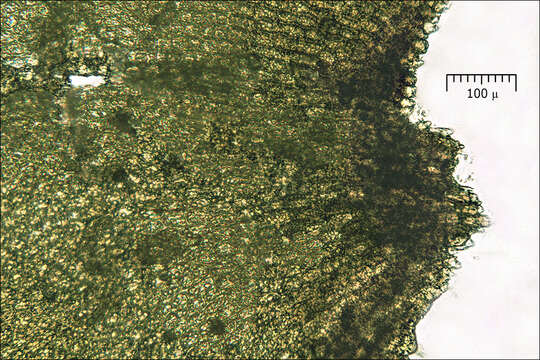Scapania-undulata_leaf-base_5M

Description:
Scapania undulata (L.) Dum., syn.: Scapania dentata Dum., Scapania intermedia (Husn.) Pears., Scapania heterophylla M. Howe, Scapania oakesii Austin.Family: ScapaniaceaeEN: Water Earwort, DE: Bach-SpatenmoosSlo.: no name fundDat.: Feb. 26. 2022Lat.: 46.35859 Long.: 13.70502Code: Bot_1437/2022_DSC5846Habitat: river bank; over flooded during river high water levels; humid ground and air; mostly in shade; average precipitations ~ 3.000 mm/year, average temperature 6-8 deg C, elevations 535 m (1.750 feet), Alpine phytogeographical region. Substratum: sandy humus layer on calcareous boulderPlace: Lower Trenta valley, between villages Soa and Trenta, left bank of river Soa, at the upper entrance into Matev's gorge, about 400 m downstream from Otokar farmhouse, Trenta 4, East Julian Alps, Posoje, Slovenia. Comments (pertain to pictures in Flicker album Scapania undulata): Scapania undulata is a relatively common liverwort and probably the most numerous of all Scapania species. There exist several species in this genus, which are similar and not always easy to determined. Scapania undulata can be found mainly on rocks and boulders on the banks of fast flowing rivers, sometimes also under water. This find fits well to the traits of Scapania undulata: habitat is typical, taking into the account its very high variability, dimensions, shape and dentations of the leaves, absence of ventral side third row of leaves, decurrent ventral leaf lobes attachment to the stem and much less decurrent of the dorsal lobes, short and +/- strait keel (fold separating dorsal and ventral lobes of the leaf)), uniform dimensions of leaf cells all over the leaf, circularly arranged cells near leaf tip, leaf cell dimensions, oil bodies and cell walls thickness, all fit reasonably to the descriptions in the literature. What doesn't fit my expectations is the fact, that these plants were sterile, while Scapania undulata should be usually fertile according to literature. I visited this site three times in 2022 and 2023 and never found a single fertile shot. Also, according to Martini (2011) the species has not been found yet in the alpine phytogeographical region in Slovenia. However, following a recent key of genus Scapania published by Urmi (2020) determination sims correct.Ref.:(1) Smith A.J.E., The Liverworts of Britain & Ireland, Cambridge University Press (1991), p 188.(2) Paton, J.A., The Liverwort Flora of the British Isles, Brill, Leiden, Boston (2011), p 371.(3) Ian Atherton, (ed.), Mosses and Liverworts of Britain and Ireland - a field guide, British Bryological Society (2010), p 175.(4) www.britishbryologicalsociety.org.uk/learning/species-fin... (accessed March 1. 2023).(5) A. Martini, Seznam jetrenjakov (Marchantiophyta) in rogovnjakov (Anthocerotophyta) Slovenije - Annotated Checklist of Slovenian Liverworts(Marchantiophyta) and Hornworts (Anthocerotophyta), Scopolia No 72: 1-38 (2011) (6) E. Urmi, Scapania in Mitteleuropa, Swissbryophytes (2020); www.swissbryophytes.ch/keys/dichotome_schluessel/scapania... (accessed March 01. 2023)
Included On The Following Pages:
- Life (creatures)
- Cellular (cellular organisms)
- Eukaryota (eukaryotes)
- Archaeplastida (plants)
- Chloroplastida (green plants)
- Streptophyta
- Embryophytes
- Marchantiophyta (liverworts)
- Jungermanniopsida
- Jungermanniidae
- Jungermanniales (Leafy liverworts)
- Cephaloziineae
- Scapaniaceae
- Scapania
- Scapania
- Scapania undulata
This image is not featured in any collections.
Source Information
- license
- cc-by-nc-sa
- copyright
- Amadej Trnkoczy
- photographer
- Amadej Trnkoczy
- original
- original media file
- visit source
- partner site
- Flickr Group
- ID


